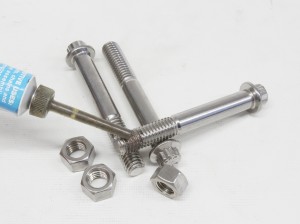I was helping my buddy remove the heads from his truck this last weekend. We ran into a problem where two of the collector bolts on the passenger side header flange were rusted so badly that we rounded off the bolt heads. This left us no choice but to cut them off with a Sawzall. That was not fun. Is there a way to prevent this from happening again? Stainless steel bolts perhaps?
D.S.
Jeff Smith: You’re on the right track. Stainless steel bolts are a great way to prevent corrosion in this location because normal steel bolts rust mainly from the multiple heat cycles. Stainless steel will prevent rusting, but you don’t want to use bare stainless steel nuts. The problem here is that these similar metals tend to fuse together – often referred to as thread galling. This is a problem for metals such as aluminum, stainless steel, and titanium. These metals produce a surface oxide coating that prevents corrosion. When heavily loaded, the surface oxides tend to break off and transfer across the high points of both the bolt and nut. The result is when removing the nut, the galling essentially locks the threads and the bolt normally breaks or you have to cut it off. And that puts you right back where you started.
 I called Chis Brown, ARP’s resident engineer, to get his recommendation. Chris agreed that a stainless bolt will solve the corrosion problem but that a stainless nut is not necessarily the best answer. ARP has actually just introduced a kit for this exact application that contains six stainless steel 3/8-inch bolts with six 12-point locking nuts. The steel nuts have a three-point crimp to help maintain the original torque while also cad plated and then finally applied with a dry film lubrication coating that is the same coating applied to the ARP’s NASCAR wheel studs. The kits come in three different under-head length bolts. The bolts are the same 300 stainless used in many other kits with a tensile strength rating of between 170,000 and 190,000 psi which makes it plenty strong.
I called Chis Brown, ARP’s resident engineer, to get his recommendation. Chris agreed that a stainless bolt will solve the corrosion problem but that a stainless nut is not necessarily the best answer. ARP has actually just introduced a kit for this exact application that contains six stainless steel 3/8-inch bolts with six 12-point locking nuts. The steel nuts have a three-point crimp to help maintain the original torque while also cad plated and then finally applied with a dry film lubrication coating that is the same coating applied to the ARP’s NASCAR wheel studs. The kits come in three different under-head length bolts. The bolts are the same 300 stainless used in many other kits with a tensile strength rating of between 170,000 and 190,000 psi which makes it plenty strong.
Brown says that using these dissimilar metals will prevent galling while minimizing corrosion even with elevated exhaust collector temperatures. One solution we thought might work is to use stainless nuts and bolts while using ARP’s Ultra-Torque thread assembly lubricant. Unfortunately, according to Brown, this won’t fly because Ultra-Torque’s melting point is roughly 400 degrees F, which is below the operating temperature of most header collectors.
If you’d rather not use the locking 12-point nuts in the ARP kit, you could substitute stainless steel nuts and use an anti-seize compound like Permatex’s Anti-Seize (PN 81343, 1 oz. tube). This stuff has a temperature range of -60 F to 1,600 degrees F so it can handle the heat. Going one better, copper anti-seize will take up to 1,800 degrees F! Using this Copper anti-seize between the threads would dramatically improve the chances of easily removing the nuts from the stainless bolts without galling. We’ve also seen brass nuts used on exhaust manifolds. You can sometimes find brass 3/8 coarse thread nuts at local hardware stores. Clearly, these will not take the same amount of torque as a steel nut, but should offer sufficient clamp load to keep the gaskets sealed.

Although aluminum based anti seize is messy, I prefer using the stainless nuts with the stainless bolts.
If I’m not mistaken.
Zinc based silver-grade anti-seize is superior in every way to copper anti-seize. Escoeically because it better suited for extreme heat than copper.
Andrew, you are correct. This is the better product Permatex “77164” from the aforementioned manufacturer. It has a much higher temperature of protection.
If I used thin walled stainless steel Gardserts made exclusively by Gard Specialists with zinc based silver grade anti seize with stainless steel bolts for exhaust manifold repairs would they ever rust or gall for any future manifold repairs?